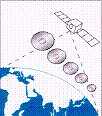 |
INTERNATIONAL SYMPOSIUM ON INFORMATION TECHNOLOGY IN OCEANOGRAPHY (ITO-98) GOA, INDIA 12-16 OCTOBER 1998 |
 |
INTERNATIONAL SYMPOSIUM ON INFORMATION TECHNOLOGY IN OCEANOGRAPHY (ITO-98) GOA, INDIA 12-16 OCTOBER 1998 |
Status of Present and Planned Ocean Colour Sensor, Data Availability, Utilisation and Infrastructure requirement.
K.H. Rao, S. B. Choudhury, M. V. Rao, S.
K. Sasmal, I.V.Ramana |
Ocean colour sensor provide a crucial insight into the marine biosphere and having the capability to quantify some of the fundamental properties, mainly on optical attenuation i.e. the depth of solar penetration, heating and depth at which photosynthesis can occur. The abundance and distribution of plant pigments, surrogate for biomass, marine phytoplankton and concentration of coloured dissolved organic carbon. Key feature of the global biosphere are basin scale river plumes dispersion patterns, identifying the upwelling zones, their extent and variability, richness of the high latitude ecosystem and internal variation in biosphere components related to El Nino and La Nino. The existing and the projected ocean colour sensors i.e. Modular Opto-electronic Scanner (MOSB) onboard IRS-P3 SeaWIFS onboard SEASTAR and planned sensor like IRS-P4/OCM, MODIS, MERIS/ENVISAT1 etc., give an opportunity to estimate the biological productivity and marine biosphere C02 uptake. It also provides the essential data to refine the understanding of the marine biosphere and its response to global changes and to quantify the feed back mechanisms between marine biosphere and global climate.
Marine biosphere is an essential component of earth's system, which maintains condition crucial for the life on the planet. It provides 20% of the food and half the 02 used by mankind. Quantifying many of the roles of the marine biosphere in the earth system and predicting how components of the marine biosphere will respond to environmental changes on global, regional and local scales are extremely difficult. The internal linkages are highly complex and source of variability exists on all scales from meters to thousands of kilometres. Sampling is very difficult and expensive. Oceans and their biosphere are constantly changing in response to atmospheric and radiative forcing and it is virtually impossible to obtain synoptic or long term views of ocean physics and biology using traditional measurements by ships and moorings etc.
Taking into consideration of vital link between ocean colour and marine biosphere systems, a thorough review of the characteristics of the sensors, scientific goals, data availability and algorithms for retrieval of geophysical parameters is conceived at this juncture. The proposed paper mainly describes Indian programme on Ocean Colour sensor onboard IRS-P4, data availability, planned data product. Main emphasis is given on required instrumentation, infrastructure for data collection, data processing and algorithm development. It gives insight into the required planning for calibration, validation paradigm, data product validation and trained man power requirement.
[ITO - 98] [Welcome] [1998 - International Year of the Oceans] [Objectives of ITO-98] [Plenary Lectures] [Technical Sessions] [Commercial/Corporate Presentation] [Exhibition/Demonstration] [Ocean IT CDROM] [Awards/Financial Assistance] [Fees / Charges] [Souvenir] [Post Symposium Event] [International Scientific Programme Committee] [Organizing Committee] [Schedule] [Scientific Programme Summary] [The Host] [Travelling / Accomodation] [Registration Forms] [Abstracts]
 |
|
 |

Copyright© National Institute Of Oceanography,
Goa,India,1998
updated on 7th July'98